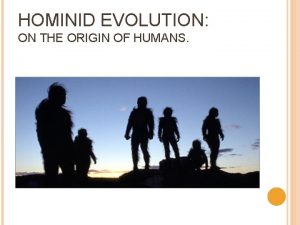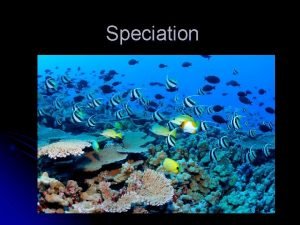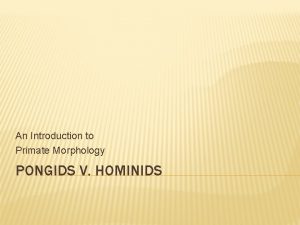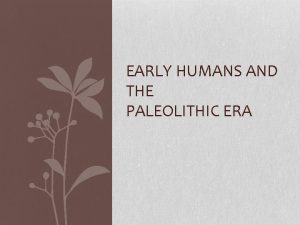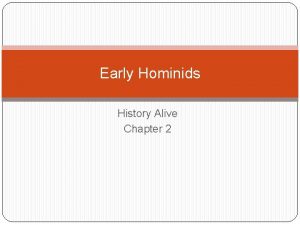A Recipe for Disaster Rise of the Hominids


































- Slides: 34

A Recipe for Disaster: Rise of the Hominids

Misconceptions: 1) Our ancestors were apes Contrary to popular belief, evolutionists do not claim we evolved directly from apes. More likely, we evolved from a common ancestor. In other words we are related to apes, but did not necessarily evolve from them. 2) Hominid evolution progressed along a single linear track directly from primitive ancestor to modern form. Most evolutionists acknowledge assert that hominids evolved several branches (more like a bush than a stick) and that some of these branches overlapped in time and space.

Hominid evolution: General pattern through time (note coexistence of forms during some time periods)

First human-like ancestor = 4 Ma

morphological trends Ape-like ancestors to Australopithecines: Pelvis becomes shorter and flatter, pelvic canal expands Legs longer, arms shorter Digits shorter and straighter Foramen magnum (attachment area at base of skull) becomes directed downward

Bipedal Locomotion Footprints of Australopithecus in volcanic ash (about 4 million years ago) Male + Female (with child ? )

Australopithecines To Homo ? “robust Australopithecines” e. g. Paranthropus (Australopithecus) boisei Australopithecus garhi ? ? Australopithecus afarensis ? Australopithecus africanus Australopithecus anamensis Ardipithecus ramidus

Appearance of genus Homo First Homo (about 2. 5 Ma)

Australopithecus to Homo: Body size increases Change from largely herbivorous to omnivorous diet Bony facial ridges progressively reduced Upper and lower jaws protrude less Tooth number reduced Tooth morphology changes: sharper molars Cranial capacity increases Habitat changes from woodland to savanna Tool use Discovery and increased use of fire Development of language Development of prolonged parental care

Also, an overall increase in brain size

Early part of Homo lineage Homo ergaster ? Homo habilis ? Homo rudolphensis Australopithecines or common ancestor ?

Later part of Homo lineage (More accepted path) Homo neanderthalensis ? Homo sapiens ? Homo erectus Homo heidelbergensis Homo ergaster

Early Technology Tools with more refined, bifaced edge younger Use of fire Acheulean tools (1. 5 -0. 2 Ma) Homo ergaster, H. erectus, Homo heidelbergensis Simple tools with Chopping/cutting edge Oldowan tools (2. 4 -1. 5 Ma) Homo habilis/rudolphesis

Later Technology younger Sophisticated spear points Cave drawings appear by 30, 000 yrs. Paleolithic tools (40, 000 -12, 000 yrs. ) (Homo sapiens) Tools with maximized cutting surface Mousterian tools (200, 000 -40, 000 yrs. ) Homo neanderthalensis, H. sapiens Acheulean tools (1. 5 -0. 2 Ma)

Development of Homo sapiens There are currently two main models to explain the development and distribution of modern Homo sapiens: 1. The Replacement Model 2. The Regional Continuity Model

Replacement Model (also known as “Out of Africa Model” and “Noah’s Ark” Model) Proposed by Christopher Stringer and Peter Andrews This model envisages modern humans evolving from archaic Homo sapiens 200, 000 -100, 000 years ago only in Africa. It is thought that modern Homo sapiens migrated from Africa into the rest of the Old World replacing all of the Neandertals and other late archaic Homo sapiens.

Replacement Model, cont’d If this interpretation is correct, all modern people share a relatively modern African ancestry.

Replacement Model, cont’d Archaic H. sapiens extinct H. erectus extinct According to this model, the regional anatomical (e. g. racial) differences that we see among humans today are recent developments--evolving only in the last 50, 000 -40, 000 years. If so, all other lines of humans that had descended from Homo erectus presumably went extinct.

Regional Continuity Model (also called Multiregional Model) The regional continuity model proposed by Milford Wolpoff (University of Michigan) envisages modern humans evolving more or less simultaneously in all major regions of the Old World from local, scattered, archaic Homo sapiens populations. Replacement Model Regional Continuity Model

Regional Continuity Model, cont’d For example, modern Chinese are seen as having evolved from Chinese archaic Homo sapiens and ultimately from Chinese Homo erectus. This would mean that the East Asians and some other peoples in the Old World have an origin of great antiquity.

Regional Continuity Model, cont’d Advocates of the regional continuity model believe that the ultimate common ancestor of all modern people was an early Homo erectus (or Homo heidelbergensis) that arose in Africa, but which rapidly dispersed to other regions. dispersal Ancestral H. erectus It is further suggested that there was sufficient gene flow among European, African, and Asian populations (via intercontinental interchange) to prevent long-term reproductive isolation and the subsequent evolution of distinct regional species.

Regional Continuity Model, cont’d It is argued that intermittent contact between people of these distant areas would have kept the human line a single species at any one time. However, the model also accomodates periods of some isolation which would have produced differing racial varieties, or subspecies, of humans.

Which Model Makes More Sense ? Later appearance in Europe and Asia 1 st appearance Fossil Evidence In Favour of Replacement Model: The oldest known modern H. sapiens remains come from Africa and adjacent areas of southwest Asia Elsewhere in the Asia and Europe, modern H. sapiens appears about 50, 000 years later Unless modern Homo sapiens remains 100, 000 years or older are found in Europe or East Asia, the replacement model best explains available data

Genetic Evidence In Favour of Replacement Model: Geneticists argue that the geographic area where modern humans have resided the longest should have the greatest amount of genetic diversity. This is based on the premise that the rate of mutation is more or less constant everywhere (so long-lived populations would show greater diversity from mutations) Through comparisons of mitochondrial DNA sequences from people in different modern populations, it was concluded that Africa has the greatest genetic diversity and therefore must be the homeland of all modern humans Assuming a specific rate of mutation, the common ancestor of all modern humans was a woman who lived 200, 000 years ago (mitochondrial Eve)

Fossil Evidence in Favour of Regional Continuity Model Proponents of the Regional Continuity Model is claim that there has been some continuity of some anatomical features from archaic Homo sapiens to modern humans in Europe and Asia. These include: 1. A heavier brow in Europeans, relative to other populations (brow shape similar to that seen in Neandertals). 2. Facial characteristics in Oriental people can be seen in Asian archaic Homo sapiens dating to 200, 000 years ago 3. East Asian commonly have shovel-shaped incisors (similar to Homo erectus) while Africans and Europeans rarely do It would seem that there is a direct local linkage between Asian Homo erectus and modern Asians and that there are sufficient differences between them among other populations to suggest a multiregional origin.

Morphological differences: Homo neanderthalensis vs. Homo sapiens Another dilemma: how closely are Neandertals related to us (subspecies of H. sapiens) or separate species ? Extinction of Neandertals: If subspecies of H. sapiens, could have interbred with other subspecies (in which case all of us could contain a little Neanderthal). Or Neanderthals belong to a separate species that went extinct due to competition with H. sapiens ?

Neandertals have gotten a bad rap Neandertals show a surprisingly sophisticated level of intelligence. Neandertals apparently had some respect for members of their groups (burial sites include evidence of flowers being buried alongside the deceased). There is evidence of long-term care for injured individuals (injuries sufficiently severe to have normally been fatal). Humeri from opposite arms of same male

Were Neandertals religious ? There is some evidence that Neandertals practiced burial rituals. Evidence includes the position of the remains (e. g. with head cradled in hand), presence of flower pollen in the grave, and animal remains (which some think was food for the individual in his/her journey to the afterlife. However, these interpretations have been doubted by a number of researchers.

More surprises continue to surface: The “Hobbit People” On Flores, an island of Indonesia, scientists have recently found skeletons of a diminutive species of human that grew no larger than a three-year-old modern child (about 1 metre high) The species is appropriately named Homo floresiensis

Who were they and where did they come from ? Homo floresiensis is is believed to be a long-term, isolated descendant of large-bodied Javanese H. erectus, though it could be a recent divergence. Once on Flores, the ancient humans could have assumed a "dwarfed" form in response to ecological pressures of the island (e. g. limited food resources). They used stone tools and coexisted on the island with dwarf elephants, giant rodents, and Komodo dragons. H. floresiensis H. sapiens

It is estimated that H. floresiensis lived on Flores between 95, 000 years ago until at least 13, 000. This means that their time range overlapped with mainland Homo sapiens. Differences from modern Homo sapiens include slightly longer arms than us (relative to the rest of the body), more conspicuous brow ridges, a sloping forehead and no chin.

Island Hopping Since sea levels were significantly lower (at least during glacial periods) during the Pleistocene epoch, and hence, some areas currently underwater were above sea level. However, these humans would still have required to cross some water to get to Flores at the time (so must have been able to construct rafts of some sort) Note: areas now underwater indicated by white outlines Pleistocene paleogeography

Implications of the new discovery The discovery of this new species has thrown yet another complication into the current understanding of human evolution.

END OF LECTURE
 Hominids
Hominids Hominids
Hominids Do monkeys have 4 hands
Do monkeys have 4 hands Tricky dicky richard nixon
Tricky dicky richard nixon Little lambs academy
Little lambs academy Rise and rise again until lambs become lions origin
Rise and rise again until lambs become lions origin Rise and rise again until lambs become lions
Rise and rise again until lambs become lions Tryck formel
Tryck formel Fuktmätningar i betong enlig rbk
Fuktmätningar i betong enlig rbk Densitet vatten
Densitet vatten Elektronik för barn
Elektronik för barn Borra hål för knoppar
Borra hål för knoppar Tack för att ni har lyssnat
Tack för att ni har lyssnat Smärtskolan kunskap för livet
Smärtskolan kunskap för livet Typiska novell drag
Typiska novell drag Mjälthilus
Mjälthilus Teckenspråk minoritetsspråk argument
Teckenspråk minoritetsspråk argument Frgar
Frgar Tallinjen
Tallinjen Indikation för kejsarsnitt på moderns önskan
Indikation för kejsarsnitt på moderns önskan Magnetsjukhus
Magnetsjukhus Toppslätskivling dos
Toppslätskivling dos Redogör för vad psykologi är
Redogör för vad psykologi är Lek med former i förskolan
Lek med former i förskolan En lathund för arbete med kontinuitetshantering
En lathund för arbete med kontinuitetshantering Bra mat för unga idrottare
Bra mat för unga idrottare Bris för vuxna
Bris för vuxna Offentlig förvaltning
Offentlig förvaltning Ledarskapsteorier
Ledarskapsteorier Datorkunskap för nybörjare
Datorkunskap för nybörjare Antikt plagg i rom
Antikt plagg i rom Steg för steg rita
Steg för steg rita Ministerstyre för och nackdelar
Ministerstyre för och nackdelar Plats för toran ark
Plats för toran ark Sju principer för tillitsbaserad styrning
Sju principer för tillitsbaserad styrning
